Notre Dame’s lackluster output against Louisville had much less of an effect in the advanced stats models than it did in our psyches – with one very notable suggestion, which we’ll get into below. While the game was certainly a frustrating one for the fans, as far as the models are concerned things went non-catastrophically. The Irish did pretty well at moving the ball outside the red zone, and did very well in holding a potentially explosive Louisville offense to a mere 233 yards of total offense. The metrics do see red zone failure, but it wasn’t enough to significantly offset positives elsewhere (yes, there were a few, believe it or not).
The big news this week is an adjustment – after the first part of the season Bill Connelly, the creator of SP+, has moved home field advantage from 1.0 point to 2.0 points. In a normal year he calculates it at 2.5 points, which has historically held up pretty well. He dropped it to 1.0 assuming that mostly-empty stadiums would sap a significant part of the advantage, but as the season has rolled on that has proven less important than expected. I included that adjustment in the updated numbers on the charts below and gone back and adjusted past weeks as well, to keep everything comparable.
Recapping the methodology for these articles: These aren’t actual SP+ win probabilities, as SP+ creator Bill Connelly doesn’t publish those regularly. He does though publish his SP+ ratings every week for all FBS teams. We used a slightly tweaked version of the formula that Reddit poster rcfbuser (account deleted, pour one out) reverse-engineered using these ratings to get close to SP+’s published probabilities. That formula does some probability magic on the differential in SP+ rating for the two teams (with a bump for home field, and yes, the bump is smaller this year given the smaller crowds), and voilà. The FPI win probabilities are updated weekly by ESPN, so those are the real deal.
SP+ can be a bit wonky from week to week at first, as creator Bill Connelly intentionally works in a lot of volatility early in the season to account for reality vs. projections. Keep that in mind when you see wild swings from one week to the next; those are by design, not by accident. SP+ measures offensive and defensive explosiveness and efficiency on a per-play basis. FPI is ESPN’s proprietary metric and is much more of a black box, but we do know that it rests heavily on expected points added, which is a pretty solid advanced stat and also a per-play number.
Post-Week 6 Update – SP+ Matrix
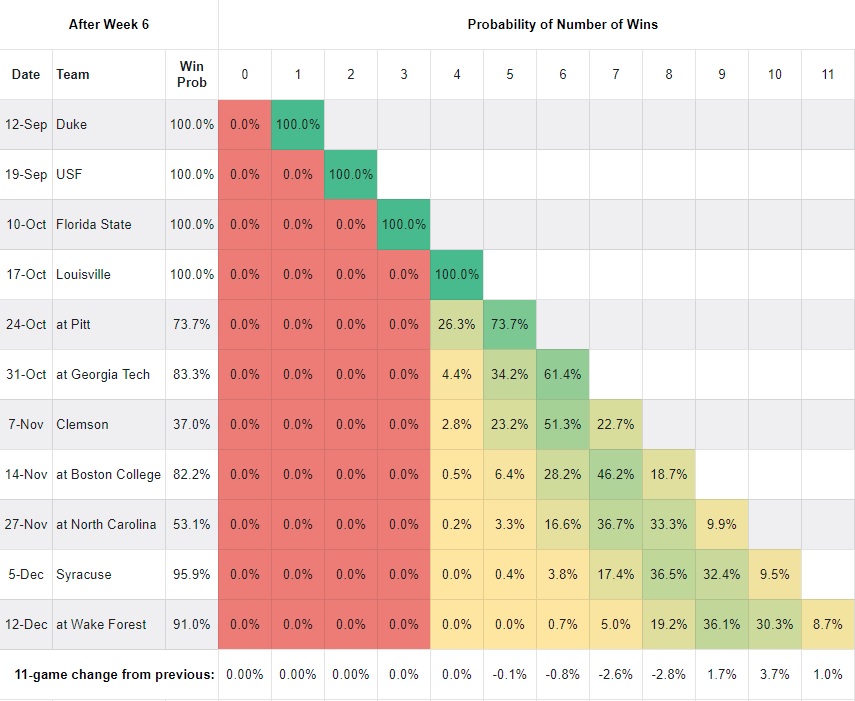
As you move down each column, you find the probability of Notre Dame owning that many wins at that point of the schedule. In the first few rows, you can see that the probability of owning 0 wins through four games is 0% and four wins is 100%, since we already won them. In the last row, we’re tracking how much the probability of each win total has changed from the previous week. This is a function of our own outcomes, the quality of play that led to those outcomes, and SP+’s changing perceptions of our past and future opponents.
The 8.7% figure at the end of the Wake Forest row reflects our probability of winning out per SP+. That’s not bad with seven games left, and in fact it increased one point this week despite the uneven performance against the Cardinals. Go figure.
Post-Week 6 Update – FPI
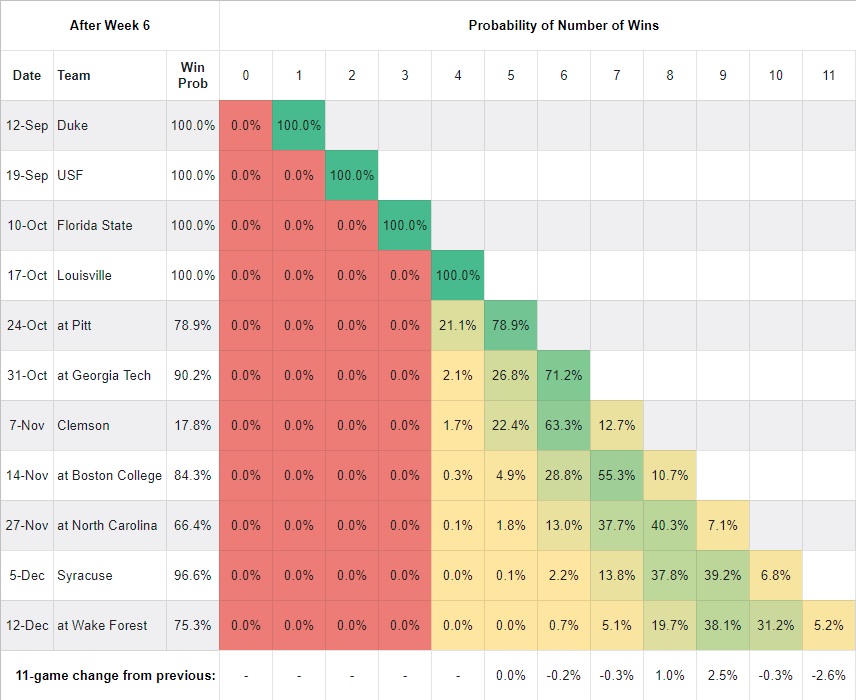
FPI continues to stick to the trend we saw in the first month of the season – it likes our chances against Pitt and UNC better and Clemson much worse than SP+ does, and it thinks of everyone else pretty much the same. Note the rather large drop in the probability of winning out, from 7.8% last week to 5.2% this week; that’s fueled by an enormous 10.1 drop in the Clemson win probability. While FPI wasn’t overly bothered by Notre Dame’s performance, as you’ll see below, it was really really impressed with Clemson’s.
Week by Week Game Trends
| SP+ | FPI | |
|---|---|---|
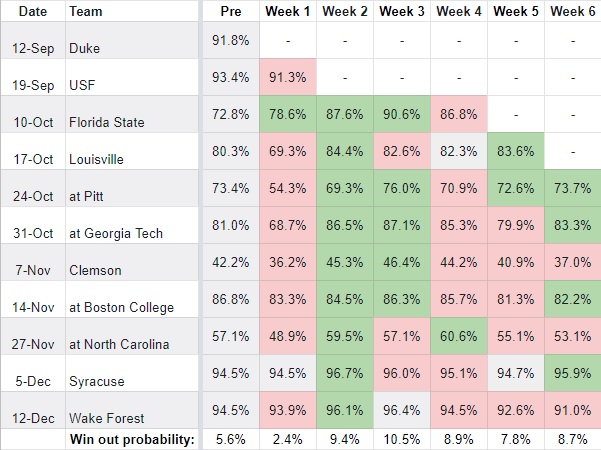 |
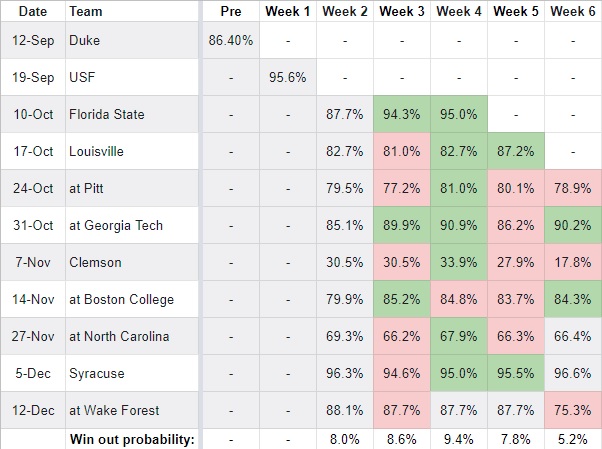 |
Here we’ll track how the probabilities move from week to week. The overall picture via SP+ pretty much stayed the same, which is reflected by the uptick in win-out probability – with 1/8 of the remaining games as of last week out of the way, the win-out probability went up by about 1/8. Neat and tidy. FPI, on the other hand… Yeesh. Pitt, Georgia Tech, Boston College, UNC, and Syracuse all stayed basically the same. Clemson dropped 10.1 points, as noted, and somehow the Wake Forest win probability dropped a whopping 12.4 points. They beat Virginia comfortably this weekend, but that hardly seems enough to explain the shift.
I actually think that for whatever reason ESPN hadn’t updated that game in a few weeks, given that the odds of a game probability staying exactly the same for three straight weeks seem pretty slim. In that three weekend stretch Wake hammered FCS Campbell and had a week off, but even with no data you’d expect the numbers to move based on other developments. As they do during Notre Dame’s bye weeks. The Deacons host a ranked Virginia Tech team this week, so they’ll have a chance to prove themselves.
Closing Thoughts
In Pitt, Notre Dame will face easily the toughest defense it’s seen to date per SP+ – the Pitt defense ranks 17th, while Duke ranks 43rd. How the Irish offense will respond to that test is anyone’s guess. Florida State was mediocre and got shoved all over the field, for the most part. Louisville was worse and only gave up one touchdown. USF, believe it or not, 56th in SP+ defense and of course got utterly obliterated. The COVID layoff certainly didn’t do the team any favors, but on the third game back it’s time for both sides of the ball to click at once. I’d argue that that’s only happened against USF so far. Another note to keep in mind here is that this will be Notre Dame’s first road game of the season; Wake Forest should’ve been the first, but, you know. How will the team respond to that?
Ohio State will almost certainly pass Notre Dame in the polls after this weekend, no matter what happens. Whether the Irish fall farther will likely depend on how dominant they look against Pitt. Fire it up, fellas… Also, it’s worth pointing out that the Irish are prohibitive favorites in five of their seven remaining games, as they were in the first four games. In the midst of the occasionally brilliant, if also occasionally frustrating, run of the last few seasons, it might be worthwhile to take a step back and remember a time not so long ago when being the prohibitive favorite in 80% of one’s season was a feeling foreign to Irish fans. Time marches on.

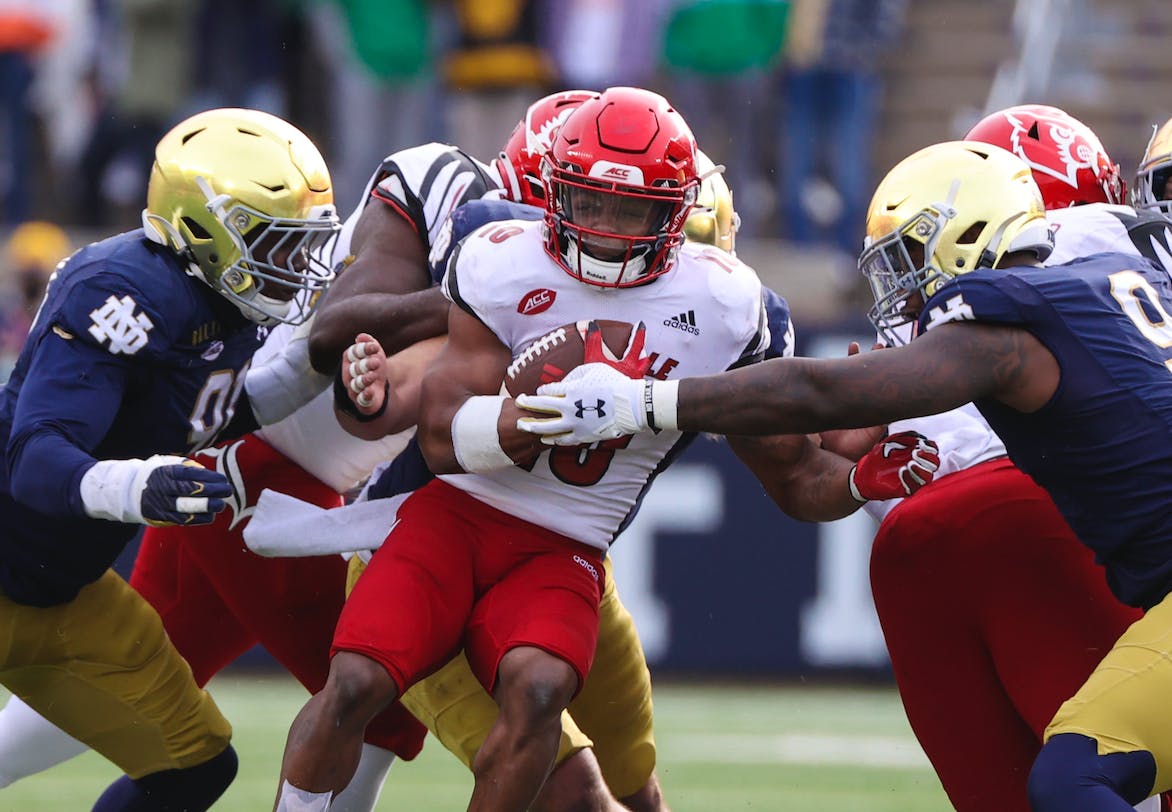



Always love to track these and see how the numbers fluctuate. SP+ has Notre Dame as 4th right now, no? Kinda surprising that there’s “only” a 61.4% chance right now of them winning the next two games to get to Clemson. I wonder why that is. That feels a bit too low in a logical sense.
I’d probably give us a little better odds than that, but 61% doesn’t seem crazy low to me given that it’s back-to-back road games against teams that aren’t completely terrible.
Pitt, I get. They were like 30 seconds away from winning a game to be 4-0 on the season, lost it and now are suddenly 3-3 due to a QB injury and other random craziness. They’re not bad and have a realistic, though small chance of beating Notre Dame.
Georgia Tech just lost 73-7. I know Clemson is a different class than almost everyone, but I just can’t see a ND team that basically never loses to unranked teams having a 16.7% chance of losing that game.
Similar to your thought below though, I also agree that a 37% chance for ND to beat Clemson is also several ticks too high.
ND vs. Lousiville: 12-7
GT vs. Louisville: 46-27
Not saying I think we’re going to lose (or that I think it’s even going to be close), but a 17% chance of a loss, on the road in Atlanta, doesn’t seem unreasonable. In fact, I think the odds of us losing that game are about the same as the odds of us beating Clemson.
Maybe! Personally I’d like to believe ND’s true talent level and ability is a lot closer to Clemson than GT is to ND but we shall find out. In SP+ this week, for instance Clemson is 2nd, ND is 7th, Georgia Tech is 60th. I don’t really see a world where GT has any hope of beating ND, besides the fluke happenings we know and love in college football
The Louisville final doesn’t really bug me too much considering they kneeled in the red zone and Kelly took 4 points off the board. That game was pretty lopsided, even though the scoreboard didn’t reflect it, frustratingly enough.
Fair, although I don’t really see a world where ND has any hope of beating Clemson, besides the fluke happenings we know and love in college football. I’m not sure there are more than 4 total positions on offense and defense where we have better players than Clemson.
That’s real. And Lawrence being (probably by far) the best player on the field on either side is a huge edge given the importance of the QB position.
But, I mean Notre Dame was hanging tough with Clemson in 2018 until Love got hurt despite Clemson being a superior team, which clearly they were. ND had a chance for a 2-minute drive to win the game @UGA.
ND likely is always going come up short against the absolute elite since Notre Dame is lesser, and I get that’s discouraging…But sometimes I think ND fans get too down on them.
60% across two games isn’t bad. Also, keep in mind that the win probabilities work kind of like a bell curve – the further you get from 50% in each direction, the harder it gets to move further out.
To add some more context here, these are the SP+ spreads for each game (there’s no available formula for using FPI to calculate spreads):
Pitt – ND -11
GT – ND -17
Clemson – ND +6 (really)
BC – ND -16.5
UNC – ND -1.5
Syracuse – ND -31
Wake Forest – ND -20
SP+ had the 2018 Clemson game as ND +10.5, which had Love stayed healthy we probably would’ve covered. FWIW.
Describing ND’s effort as “lackluster” in the 3rd word of the review of a game where we completely dominated a talented offense and held the other team to 7 points is ridiculous.
We missed covering by 15 points. We went 1/4 on TDs on meaningful red zone possessions. The running game was fine but we averaged 5.8 yards per attempt. Book also got away with a couple of pick-worthy throws.
I agree that the defense was excellent. The offense was lackluster, and if it wasn’t we would’ve won something like 27-7. Perhaps uneven or disappointing or something along those lines would be a better fit, but in the end I certainly wasn’t energized by that game.
An 8.2% chance to go undefeated? It doesn’t even like there’s an 8% chance to beat Clemson right now. Beyond that beat pitt and 9-2 pretty much becomes the minimum. It’s not a very good schedule.
Again always enjoy these and hoping to be reviewing this coming off a win next week. A win and the hype will start to get turned up for November 7
I said in my Instant Reaction on Saturday that whatever percentage the stats gave us against Clemson would still seem way too high. It still definitely does. SP+ giving us a 37% chance??? Feels like crazy talk.
I feel like some of these evaluations might underrate how much better the top 3 programs are than everybody else right now.
Ugh I just noticed Clemson plays BC the week before us. The worst parts of our fanbase are going to throw a fit when BC loses by 40 but Jurko throws for 250 yards and 2 TDs (in garbage time).
If that’s the worst thing that happens from Nov 1 to Nov 6, I think we’ll all be just fine
Well, he had 2 ints and a lost fumble last week